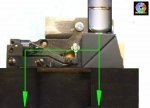Need some advice:
Basically, we are trying build an apparatus with 2 lasers (set apart at a fixed distance of 2 cm, accurate to the 0.1 mm) which can then be attached to a variety of cameras by the 1/4 in. screw standard for tripod attachments.
We had a previous system built, but the problem is that the casing which houses the laser does not accurately parallel the laser itself.
I need to find small lasers (green preferably) that have a very small diameter (preferably no more than 1-2 mm in diameter) with small casing which is accurately parallel to the laser it houses. And these lasers need to be able to make contact with sensitive skin without any harmful effects.
Sorry if this is a very basic question, but I really don't know much about lasers and we are in some real need of advice.
I can post pictures of our previous system if necessary to give a better idea.
Any help would be great.
Thanks.
Basically, we are trying build an apparatus with 2 lasers (set apart at a fixed distance of 2 cm, accurate to the 0.1 mm) which can then be attached to a variety of cameras by the 1/4 in. screw standard for tripod attachments.
We had a previous system built, but the problem is that the casing which houses the laser does not accurately parallel the laser itself.
I need to find small lasers (green preferably) that have a very small diameter (preferably no more than 1-2 mm in diameter) with small casing which is accurately parallel to the laser it houses. And these lasers need to be able to make contact with sensitive skin without any harmful effects.
Sorry if this is a very basic question, but I really don't know much about lasers and we are in some real need of advice.
I can post pictures of our previous system if necessary to give a better idea.
Any help would be great.
Thanks.





